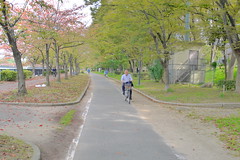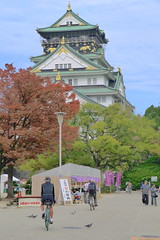 日本自転車都市ベスト5
日本自転車都市ベスト5Here is CycleKyoto's subjective list on the best urban areas for cycling in Japan, 2013.
1. Osaka
2. Tokyo
3. Kyoto
4. Nara
5. Hiroshima
To be honest, we have not cycled in Sapporo, Sendai, Kamakura or Fukuoka. Sapporo is too cold, Sendai we don't know. Kamakura we love and have walked much of it, but with a population of only 160,000 it is a bit too small for this survey (we made the cutoff at 300,000). Fukuoka is a great city and on the "must cycle soon" list.
The most "surprising" omission will be Nagoya. For those who follow Copenhagenize and its annual ranking of best cities worldwide for cycling, in 2013 Tokyo finished 10th and Nagoya tied for 11th with Munich and Montreal (the criteria the blog uses are listed below in italics).
Even a close reading of the criteria leaves us scratching our helmeted head. Tokyo, yes. In terms of cycling culture, facilities, gender split, modal share, safety, Tokyo - almost any Japanese city - would score well. But Nagoya? The home of Toyota, wide car-filled boulevards, and as suburban as any city in Japan with the most deeply entrenched automobile culture in the country? Please.
 For good urban cycling, Osaka takes the Japanese crown. It is flat, relatively compact, has many bike lanes (most on wide wide sidewalks), and a deep cycling culture. From salarymen to grandmoms, students to hipsters, nearly everyone is on a bike. To Osakans, a bike is a tool, an extension of the body used to get from A to B.
For good urban cycling, Osaka takes the Japanese crown. It is flat, relatively compact, has many bike lanes (most on wide wide sidewalks), and a deep cycling culture. From salarymen to grandmoms, students to hipsters, nearly everyone is on a bike. To Osakans, a bike is a tool, an extension of the body used to get from A to B.Tokyo comes in a close second to Osaka because it is hillier, more spread out, and busier.
Kyoto is the perfect size, mainly flat until you hit the mountains that surround the city, home to more than 100,000 university students (out of a population 1.5 million), and has a long and enduring bike culture. The city's efforts at improving the infrastructure have been hit or miss, but dearth of bike lanes notwithstanding the city is still a great place to ride.
Nara is small and chill and a great place to get around on a bike, whether you are a tourist or a resident.
Hiroshima got in by the skin of its teeth. We have a soft spot for the city - the rivers, wide streets, trams, great vibe, fun nightlife - but not having cycled Fukuoka or Sendai, this ranking comes with an asterisk.
Here are the Copenhagenize criteria for ranking cities:
Advocacy:
How is the city's (or region/country) advocacy NGO(s) regarded and what level of influence does it have?
Rated from no organised advocacy to strong advocacy with political influence.
Bicycle Culture:
Has the bicycle reestablished itself as transport among regular citizens or only sub-cultures?
Rated from no bicycles on the urban landscape/only sporty cyclists to mainstream acceptance of the bicycle.
Bicycle Facilities:
Are there readily accessible bike racks, ramps on stairs, space allocated on trains and buses and well-designed wayfinding, etc?
Rated from no bicycle facilities available to widespread and innovative facilities.
Bicycle Infrastructure:
How does the city's bicycle infrastructure rate?
Rated from no infrastructure/cyclists relegated to using car lanes to high level of safe, separated cycle tracks.
 Bike Share Programme:
Bike Share Programme: Does the city have a comprehensive and well-used bike-sharing programme?
Rated from no bike share programme to comprehensive, high-usage programme.
Gender Split
What percentage of the city's cyclists are male and female?
Rated from overwhelming male to an even gender split or more women than men cycling.
Modal Share For Bicycles:
What percentage of modal share is made up by cyclists?
Rated from under 1% to over 25%.
Modal Share Increase Since 2006:
What has the increase in modal share been since 2006 - the year that urban cycling started to kick off?
Rated from under 1% to 5%+.
Perception of Safety:
Is the perception of safety of the cyclists in the city, reflected in helmet-wearing rates, positive or are cyclists riding scared due to helmet promotion and scare campaigns?
Rated from mandatory helmet laws with constant promotion of helmets to low helmet-usage rate.
Politics:
What is the political climate regarding urban cycling?
Rated from the bicycle being non-existent on a political level to active and passionate political involvement.
Social Acceptance:
How do drivers and the community at large regard urban cyclists?
Rated from no social acceptance to widespread social acceptance.
Urban Planning:
How much emphasis do the city's planners place on bicycle infrastructure - and are they well-informed about international best practice?
Rated from car-centric urban planners to planners who think bicycle - and pedestrian - first.
Traffic Calming:
What efforts have been made to lower speed limits - for example 30 km/h zones - and generally calm traffic in order to provide greater safety to pedestrians and cyclists?
Rated from none at all to extensive traffic-calming measures prioritising cyclists and pedestrians in the traffic hierarchy.
© CycleKyoto.com
Tags Japan Touring Kyoto Cycle Japanese
2 comments:
Kanazawa has surprisingly good bicycle infrastructure. I was on a visit there with family and ended up taking plenty of photographs for a blog article. I wish every city in Japan had Kanazawa's cycling infrastructure.
Kanazawa, its better by Bike
Last February and March I cycled from Narita ,eventually to Tokushima. The one city that stood out for cycling infrastructure (paths, bicycle stands ) was Nagoya .I had been there back in 2007 , but this time the city had taken on a whole new image.I have some photos on my Flickr site (kiddus_i2003) I posted a few but not all. I don't remember exactly where the paths started ,but I had cycled that day from Anjo to Nagoya.I seriously believe that these cycle ways are just behind Shimanami Kaido for cycle friendly,just a shame I didn't stay more than 2 nights.
Post a Comment